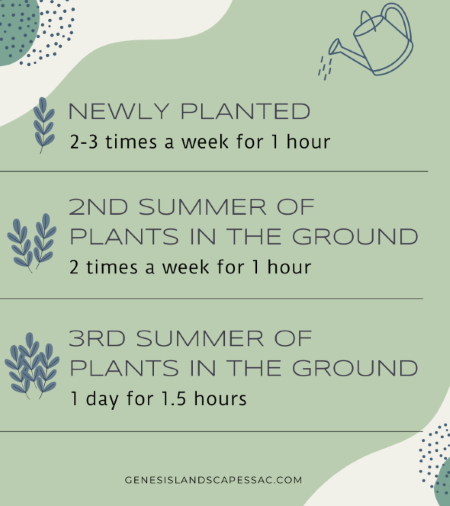Spring Irrigation Adjustments
Weather is undoubtedly unpredictable. We have seen more rain this season than usual and hopefully you are enjoying mother nature’s irrigation water this past winter and early spring. Being the smart gardener that you are, you have adjusted your irrigation accordingly and reduced the watering cadence for your yard based on your plant and vegetation characteristics.
However, with approximately 2 more months until summer officially begins, it is inevitable that the dryer season is approaching. April is an excellent time to start checking your irrigation lines and get prepared to increase that water flow.
Visual Irrigation Check
Go through each irrigation valve by turning them on one at a time and walk over to that section in your yard, move any mulch to uncover lines and check for any necessary irrigation fixes. Leaks typically don't spring up on their own from the drip system. Majority of the time an animal got to it or it was nicked by something. If you do find a leak, all you need to do is cut the leaking irrigation line with pruners and insert a coupling to rettach. Run your irrigation again and confirm that your fix did the trick!
Likewise, take notice of any drip emitters that need to be moved or adjusted based on your plant's growth. If you need to add more drip, you’ll need 1/4" tubing with 0.5 GPH emitters that go into the existing drip line. Puncture the main line with something first (a landscape staple works or you can purchase one of these tools), then insert the emitter into the existing ½”line and attach the length of ¼” tubing needed to reach the new plant.
Spring to Late Summer Irrigation Schedule
As the ground starts to dry and rains are less frequent, you will want to turn on your irrigation system by the following the suggested watering cadence to the right; adding more frequency during a heat wave.
Water only when soil is dry to a depth of several inches. Longer watering will encourage roots to grow downward, when moisture is more easily accessible, to nurture a healthy, happy plant!
Likewise, you’ll want to add mulch to conserve moisture during dry weather and as a bonus minimize weed growth. Organic mulches add beneficial nutrients to the soil. We typically used shredded cedar or redwood — they are more fibrous and tend to mat down to create a better barrier against moisture evaporation and weeds. They also move around the least out of all the wood mulches when leaf season rolls around.
Smart Irrigation Systems
There is another option for more accurately watering your yard. If you don’t already have one installed, it could be greatly beneficial to your yard and savings on your water bill to install a smart irrigation system. With these systems, it will automatically adjust by either weather-based controllers or soil moisture-based controllers. You can see if you have a smart irrigation system by checking for a WaterSense label.
“WaterSense labels two types of irrigation controllers that can help homeowners and businesses make their irrigation scheduling more water-efficient: weather-based irrigation controllers use local weather and landscape conditions to tailor watering schedules, and soil moisture-based irrigation controllers (also known as soil moisture sensors, or SMSs) monitor moisture levels in the soil to prevent irrigation when water is not needed.”
-EPA
WaterSense irrigation controllers can improve your maintenance and water use for your yard. And a really cool feature they can provide is notifying you when it's going to delay watering due to rain. So super helpful!
Image credit: EPA website
Pro Tips for Plant Irrigation
As with most things in life, there is no one perfect formula for you to fully rely on with the set it and forget it mentality. Based on many environmental and ecological factors, taking the time to periodically walk your garden and make adjustments is key to a flourishing yard. Some things to look out for in your yard that will tell you when you need to adjust your watering:
Yellowing is usually a sign of too much water
Recommendation: Delay your irrigation and monitor the soil
Wilting in the morning is a lack of water
Recommendation: Manually run irrigation or hose water on low for 30 mins. Drooping in the afternoon heat is normal but drooping in the morning is a sign that the plants are thirsty. Run a “Quick Run” on your irrigation system to give them a little extra water.
Dry leaves can indicate too much or too little water
Recommendation: If it is an established plant, we always recommend feeling the soil and either skipping the next watering if it’s wet or watering more if it’s bone dry to ensure the soil is cool and damp. They should recover with your adjustment.
Our projects stand out from the crowd with a hand-picked curation of native and drought-tolerant plants that are compatible with the homeowner and their community. We have the knowledge and access to local plant varieties to create a custom plant selection and design to fit any style. For all the landscapes we design and install, we provide a plant maintenance and irrigation guide to set you up for success!
Check out our process from start to finish.


